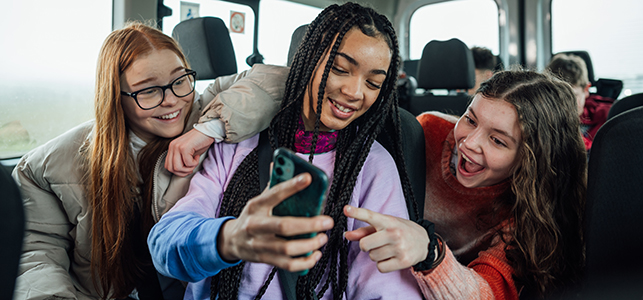
Mental health and poison center experts explain what parents need to know about these trends that pose serious risks for kids
Is your adolescent on social media? If so, you’ll want to keep reading.
Social media challenges come and go, but not always without dire consequences. The following experts answer essential questions about what the challenges are and how to talk to kids and teens about the risks involved.
- Shelly Clary, MA, education specialist, Virginia Poison Center at VCU Health
- Michele Cosby, PsyD, LCP, clinical psychologist, Virginia Treatment Center for Children
- Kristin Wenger, MA, BS, education coordinator, Blue Ridge Poison Center at UVA Health
What exactly is a social media challenge?
Kristin: A social media challenge starts when someone attempts a task, films themselves doing it, then posts the video on a social media platform like TikTok or YouTube. If videos become popular, more and more people start to copy and challenge others to participate too.
Some social media challenges, like silly dance routines, are harmless fun. Others, though they may start innocently, are quite dangerous and can result in serious injuries. Popular, but unsafe, social media challenges recently have included the Benadryl® challenge, sleepy chicken challenge, nutmeg challenge, one chip challenge, cinnamon challenge and chroming (inhalant abuse).
Why are adolescents so attracted to social media challenges?
Dr. Cosby: There are several reasons social media challenges are appealing to young people.
- Developmental stage and need for social approval
Adolescence is a time of growth and development. The time from ages 14-17 is one for building relationships with peers, which can create distance between teens and parents. This shift makes approval from peers increasingly important. Social media allows for an instant source of following, praise, attention and approval.
- Behavior at this stage of development is driven by emotion, not logic
The part of the brain responsible for logical decision making isn’t fully formed until we’ve reached our mid-20s. The developing adolescent brain is focused on the emotional high of an experience in the moment, not the long-term consequences.
- Social media rewards outrageous behavior
The more ridiculous or absurd a behavior on social media, the better. The rapid response creates an immediate sense of happiness, attention and an adrenaline rush.
- The more ridiculous, the more likes, views, shares and subscribers
The greater and more rapid the response, the more likely adolescents will be to look for something even bigger, better and more intense the next go around.
How can parents, teachers, coaches and caretakers help prevent adolescents from being harmed by popular social media challenges?
Dr. Cosby: It’s impossible to predict what the next big challenge will be, but you can talk generally about the motivations behind them, and potential risks involved. I encourage adults to:
- Have conversations.
Make space and time to have conversations with your adolescent. Pay attention and stay in the know – ask about their day, how they’re feeling, how their friends are doing.
- Become friends with your children on social media.
Know what they’re posting so you can not only be aware and observant when trouble arises, but also offer praise for a positive and appropriate social media presence.
- Validate the need to engage in trends and openly discuss risks.
Let them know you understand the desire to do what peers are doing and discuss the importance of recognizing the risks of being involved. This could be as serious as medical emergencies and hospitalization.
- Model and encourage healthy social media habits for the family.
Reflect on your own social media habits and what they’re teaching your teen. Adolescents learn more from what they see us doing than what we tell them. Discuss with them why and how you use your social media and nurture discussions around rational decision making.
Communication is key. Here are some conversation tips:
- Be intentional about encouraging conversation. This could be at dinner, in the car or another time/place that lends itself to talking.
- Don’t wait for trouble to talk. Setting the tone that talking is normal and expected will make it easier to bring up difficult conversations when needed.
- Ask about what their friends/peers are doing.
- Ask about challenges they’ve heard of and their thoughts.
- Be curious, but not judgmental.
- If they want to participate in a challenge, ask open ended questions to learn why and ensure they understand potential risks. Be open to learning about them together.
What happens in the event of an emergency? How can poison centers help?
Shelly: While we can try our best to prevent them, injuries happen. In the case of social media challenges, many of these injuries are related to eating, inhaling or exposure to substances that lead to poisonings. As adolescents begin to spend more time away from parents, it’s a good idea to review what to do in the event of an unexpected situation.
If it’s a medical emergency, call 9-1-1.
If there is concern of a poisoning, call the poison center at 1-800-222-1222.
- Poison centers are free to call.
- All conversations are confidential. It’s a no-judgement zone.
- Phones are staffed by individuals – usually registered nurses and pharmacists – who go through extensive training and are well versed in poison information.
- Help is available 24/7.
Please don’t be afraid to call for help! You’re only expected to answer the questions you know the answers to or provide information you’re willing to disclose. When you call, a poison information specialist will answer and quickly assess the situation by asking for information, such as:
- Age of patient
- Symptoms they’re experiencing
- Medical history
- Name of the product
- Strength/dose of product
- How long ago it happened
- Name, phone number and zip code (optional)
- Relationship to patient
They’ll then provide instructions on what to do next.
The Virginia Poison Center is here when you need it.
Find more mental health topics for kids and teens.
